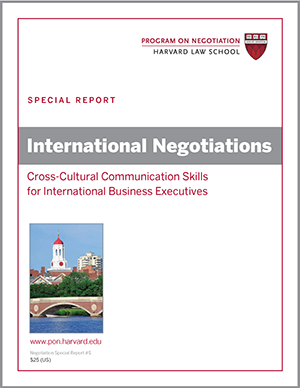
Back-channel negotiations provide temporary protection from deal spoilers and public scrutiny.
Back-channel negotiations have been used in numerous conflicts across the globe, including the Israeli-Palestinian peace process from 1994 to 1996 and the Iranian hostage crisis in 1979–1980. In 1985, the imprisoned Nelson Mandela conducted back-channel negotiations with South Africa’s minister of justice, Hendrik Jacobus Coetsee, that laid the groundwork for the end of the apartheid era. Back-channel talks are most commonly used in diplomacy, but they occur in the private sector as well, as when businesses want to negotiate highly visible disputes out of the public eye. Back-channel negotiations helped to resolve the New York City transit strike negotiations of December 2005, for example.
Why go underground?
The primary benefit of back-channel negotiations is that they remove talks from the scrutiny of an audience, including constituents, the press, and even members of one’s own negotiating team. When negotiators feel pressured by observers to take a hard-line position, they may fall back on counterproductive aggressive tactics and avoid exploring possible concessions and tradeoffs. Negotiating through a back channel enables would-be dealmakers to test the waters—to determine whether the other party is capable of negotiating in good faith—before exploring real commitments. Thus, back-channel negotiations can be particularly appealing to high-level leaders who are fearful of a public failure if their efforts to reach a deal collapse.
Back-channel talks also help negotiators circumvent potential deal spoilers, writes Wanis-St. John. When particular stakeholders have an interest in undermining the parties’ ability to reach an agreement, taking talks “underground,” at least temporarily, can give negotiators much-needed cover to search for collaborative solutions. With any luck, they may be able to reach breakthrough agreements before spoilers have had a chance to mobilize in opposition.
Back channels also help parties circumvent the need to meet preconditions to negotiating. Front-channel talks between Palestinian and Israeli leaders have often been nonstarters because one or both sides have insisted that certain conditions be met before they will sit down at the negotiating table, such as the release of prisoners or a troop withdrawal. Throughout their long conflict, the two sides have turned to back-channel negotiations to keep lines of communication open even when they aren’t officially supposed to be talking to each other.
The risks of back-channel negotiations
The benefits of back-channel negotiations also highlight some of the potential risks.
First, parties may come to feel so protected by the secretive nature of back-channel negotiations that they choose to go undercover repeatedly and stay there for as long as possible. Because most negotiations must go public in order to be implemented, back-channel negotiating may foster costly delays and perpetuate the very sort of impasse they are designed to overcome. Israeli and Palestinian leaders’ reliance on back channels from 1994 to 1996 “only created the need for further back channels and failed to peacefully resolve the conflict,” writes Wanis-St. John.
Second, back-channel negotiations provide only temporary protection from deal spoilers and public scrutiny. Indeed, critics may react even more strongly against an agreement if they believe a process was unfair. High-level leaders who felt safe while engaging in private back-channel communications may find that their reputations take a hit when constituents and colleagues learn of their secrecy. Palestinians and Israelis alike have condemned their leaders for conceding too much in back-channel negotiations.
Weighing the pros and cons of back-channel negotiations in the context of international conflict, Wanis-St. John concludes that secret negotiations can facilitate early breakthrough agreements but yield diminishing returns when relied on too frequently.
Ultimately, the goal of leaders—both in business and government—should be to build consensus among their supporters and their detractors. Though back-channel negotiations can be a useful means of jump-starting stalled talks, negotiators should aim to bring their discussions out of the shadows and into the light of day.
What’s your experience with back-channel negotiations?






In 1993, the U.S. EPA entered into a three-year waiver agreement with the City of New York pursuant to which the City could avoid constructing federally mandated water filtration systems for its system of five Catskill Mountains reservoirs if it (1) acquired a great deal of land in the watersheds of its five Catskill Mountain reservoirs and (2) developed new land use and water quality regulations and succeeded in having the State of New York promulgate them, After the commencement of litigation by the newly-formed Coalition of Watershed Towns, the City entered into negotiations with the Coalition, but the negotiations kept breaking down because of long-standing mistrust and enmity between them – including accusations of bad faith negotiation leveled against the City -and the apparent intractability of the issues. In the context of that negotiation dysfunction, the most important NGO in the Catskills, the Catskill Center for Conservation and Development, which had good relationships with both sides, asked me how it might be helpful in getting the issues resolved. I proposed a back-channel Track Two approach under the Catskill Center’s auspices, to be facilitated by me and a member of the center’s senior staff. The Center would invite representatives of leading environmental organizations in the City, which had the ear of the City’s Department of Environmental Protection, and representatives of a variety of non-profit and business organizations in the Catskills, each of which were likely to be able to influence various leaders of the Coalition, to participate. The talks would be secret, which we knew would be absolutely essential for the Catskills representatives’ participation because of how inflamed the situation had become. At the first meeting, I posed the following question to the group: Is the inability of the City and the Coalition to make any progress in the negotiations a function of the non-negotiable nature of the issues themselves or was it a function of the way the parties were talking to each other? The participants agreed to address that question, and in order to do so they realized that they needed to understand better what the nature of the other side’s interests and concerns were. Thus, though they had no authority to negotiate anything, and, indeed, weren’t being asked to come up with any solutions or agreements, they began to do what good negotiators should do, namely ask questions so as to deepen their understanding of the other side. Over the course of many months – and even some blow-ups not dissimilar to what was happening in the official Track One negotiations – the participants came to have a real grasp of what was important to each side and began to see the outlines of what a deal might look like and were able to conclude that, taken in their totality, these were soluble problems. At some point during the process, named the Catskill Watershed Water Quality Partnership, the participants began to share some of their insights with their respective Track One negotiators, with considerable impact, and three of the Coalition leaders actually asked the group for permission to attend the meetings, which permission was granted. In November 1994, Republican George Pataki was elected Governor and after his inauguration in January 1995 came under considerable pressure to take sides in the controversy. But because of the groundwork our group had laid, the governor saw that without risking real deal of political capital he could call for a restart of the negotiations under his auspices. He invited the City and the Coalition, along with other stakeholders, to come to the table anew, with the Governor’s Counsel, Michael Finnegan, to serve as the mediator. Needless to say, all those invited accepted the invitation, and in the fall of 1995 a deal was struck. The structures and policies set in place by that agreement are still in effect and are widely considered a model of watershed management.